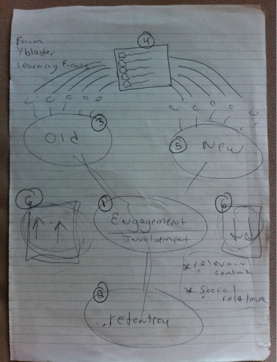In a series of brainstorming conversations with a fellow NY EOer we attempted to outline ways to increase retention within the NY EO chapter. After several rounds, he and I seemed to not be looking at the situation the same way. To figure out where the disconnect was, I drew the outline below to demonstrate what my approach would be like if I were working with one of our client schools.

To further explain my chicken scratch…
- The conversation with a school usually starts in the middle with the idea of increased student engagement and involvement.
- But one has to take a step back and ask why increased student engagement and involvement is important? Most of the time the answer is higher retention rates. Beyond intuitively making sense, there is research (Astin/Tinto) that draws the line between how engaged/involved a student is to fellow peers and his/her retention rate from year-to-year.
- The next step is to list out all the tactics that an institution is currently doing to increase engagement and involvement.
- By attaching a measurement/point system to each tactic, we can then build an Engagement Dashboard that tells us who a school’s most involved, and least involved, students are.
- If the data from the current tactics isn’t enough, then we need to brainstorm new tactics that we can create, measure, and plug into the Engagement Dashboard to get better results.
- The end result is a dashboard that gives us a clear visual of whom a school’s most involved, and least involved, students are. With this information, schools can focus their energy on celebrating the engagement/involvement of the top third while putting their limited resources into supporting the bottom third who are at the highest risk of dropping out.
For schools, being able to target the bottom third is huge because they are the most at risk. From an administrator’s perspective, each student’s tuition from year-to-year makes an impact on the bottom line of the school.
Bringing the story back to EO…
After I laid out this Engagement Plan, my brainstorming partner quickly went, “Ah-ha! I got it. Unlike a school where there is a real desire to support the bottom third and keep them in school. EO is an exclusive organization and if you aren’t up to carrying your own backpack, then we don’t want you because we only allow so many members at a time. So with our Engagement Dashboard, we are going to put all our energy into celebrating the top third.”
Makes sense. And the more I thought about it, the more I realized that not all communities want to keep increasing their numbers and retain as many members as possible. Some communities, like EO, are built on an exclusivity model.
As you build out an Engagement Dashboard for your community, make sure to be clear on if your goal is to be an exclusive or inclusive community.